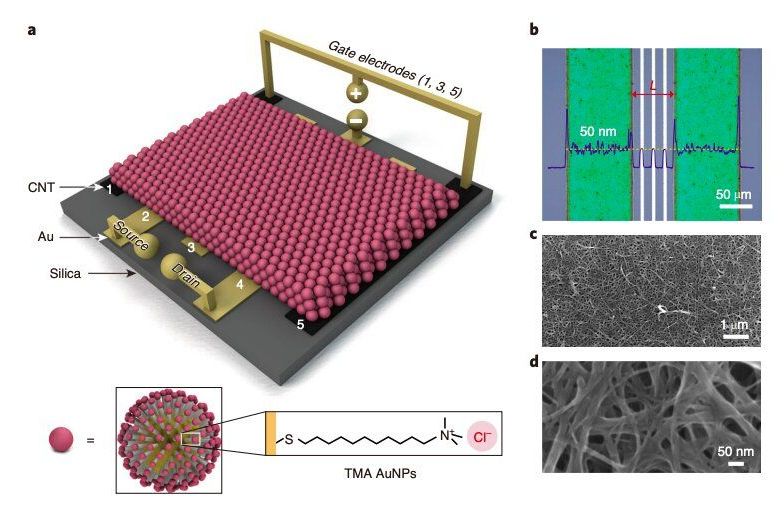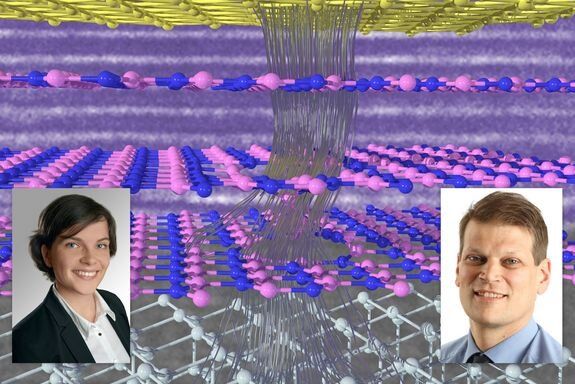The 2000-year-old mechanism has baffled experts since it was discovered on a shipwreck in 1901.



Transistors, devices that can amplify, conduct or switch electronic signals or electric current, are key components of many electronics on the market today. These devices can be fabricated using a variety of inorganic and organic semiconducting materials.
Metals are generally considered unsuitable for fabricating transistors, as they screen electric fields and thus make it difficult to realize devices with tunable electrical conductivity. A possible way to create electronic components based on metals is to use gradients of counterions in films of metal nanoparticles functionalized with charged organic ligands.
In the past, engineers have successfully used this strategy to create a variety of devices, ranging from resistors to diodes and sensors. Nonetheless, modulating the electrical conductivity of these devices has often proved to be very challenging.

The State of the Edge report is based on analysis of the potential growth of edge infrastructure from the bottom up across multiple sectors modeled by Tolaga Research. The forecast evaluates 43 use cases spanning 11 vertical industries.
The one thing these use cases have in common is a growing need to process and analyze data at the point where it is being created and consumed. Historically, IT organizations have deployed applications that process data in batch mode overnight. As organizations embrace digital business transformation initiatives, it’s becoming more apparent that data needs to be processed and analyzed at the edge in near real time.
Of course, there are multiple classes of edge computing platforms, ranging from smartphones and internet of things (IoT) gateways to complete hyperconverged infrastructure (HCI) platforms that are being employed to process data at scale at the edge of a telecommunications network.



Researchers have developed a new data transfer system that is 20 times faster than USB 3.0.
This combines high-frequency silicon chips with a polymer cable as thin as a strand of hair. The system could boost energy efficiency in data centres and lighten the loads of electronics-rich spacecraft. Researchers presented their breakthrough at the recent IEEE International Solid-State Circuits Conference, held virtually.
“There’s an explosion in the amount of information being shared between computer chips – cloud computing, the Internet, big data. And a lot of this happens over conventional copper wire,” says Jack Holloway, who led the research. Holloway completed his PhD in MIT’s Department of Electrical Engineering and Computer Science last year and currently works for Raytheon.

But Aspelmeyer and his colleagues could not declare victory quite yet: they still had to rule out the possibility that the source mass modulation was generating other forces on the test mass that would oscillate at precisely the same frequency. Periodic rocking of the table supporting the experimental apparatus, caused by recoil from the barely visible motion of the source mass, was just one of a host of confounders the researchers had to carefully quantify. In the end, they found that all known nongravitational forces would be at least 10 times smaller than the gravitational interaction.
Reaching toward Quantum Scales
Aspelmeyer believes that an improved torsion pendulum will be sensitive to gravity from masses 5000 times smaller still—lighter than a single eyelash. His ultimate goal is to experimentally test the quantum nature of gravity, a question that has perplexed physicists for nearly a century. Quantum mechanics is one of the most successful and precisely tested theories in all of science: it describes everything from the behavior of subatomic particles to the semiconductor physics that makes modern computing possible. But attempts to develop a quantum theory of gravity have repeatedly been stymied by contradictory and nonsensical predictions.

MIT scientists demonstrate a hair-like plastic polymer cable that can transmit data 10 times as fast as USB.
How fast does data flow? The answer: not fast enough.
The search for more efficient data-transfer solutions to meet the ever-increasing demand for computation never ends. Even today, most data transmission happens via traditional copper cables, which are power-hungry, leading to a compromise between data exchange and energy consumed. Fiber-optic cables are an alternative, but they don’t work well with the silicon chips in our computing systems. Overcoming these limitations, while theoretically possible, can turn out to be prohibitively expensive, especially for electronics-rich applications like data centers, spacecraft, electric vehicles and so on.
A team of scientists at the Massachusetts Institute of Technology have recently demonstrated a plastic polymer cable that is a complementary solution; it takes the best of copper wires and fiber-optics while ditching their shortcomings. Thinner and lighter than copper, this cable is capable of data transfer speeds rivaling fiber-optic threads, while being compatible with silicon chips. The team, which presented its findings at the IEEE International Solid-State Circuits Conference in February, reported data-transfer speeds topping 100 gigabits per second.

On track to hit the hundreds of thousands that they projected for 2025?
Honeywell has upgraded the commercial trapped ion quantum computer System Model H1 and achieved a quantum volume of 512. This is four times higher than when it was released in September 2020 with a quantum volume of 128. This is the highest measured on a commercial quantum computer to date. It is the third time in nine months Honeywell has set a record for quantum volume on one of its systems.

For decades, there has been a trend in microelectronics towards ever smaller and more compact transistors. 2D materials such as graphene are seen as a beacon of hope here: they are the thinnest material layers that can possibly exist, consisting of only one or a few atomic layers. Nevertheless, they can conduct electrical currents—conventional silicon technology, on the other hand, no longer works properly if the layers become too thin.
However, such materials are not used in a vacuum; they have to be combined with suitable insulators—in order to seal them off from unwanted environmental influences, and also in order to control the flow of current via the so-called field effect. Until now, hexagonal boron nitride (hBN) has frequently been used for this purpose as it forms an excellent environment for 2D materials. However, studies conducted by TU Wien, in cooperation with ETH Zurich, the Russian Ioffe Institute and researchers from Saudi Arabia and Japan, now show that, contrary to previous assumptions, thin hBN layers are not suitable as insulators for future miniaturized field-effect transistors, as exorbitant leakage currents occur. So if 2D materials are really to revolutionize the semiconductor industry, one has to start looking for other insulator materials. The study has now been published in the scientific journal Nature Electronics.